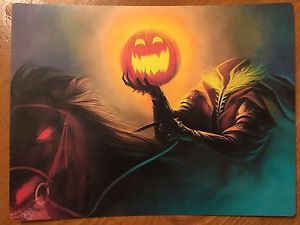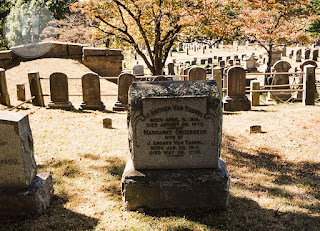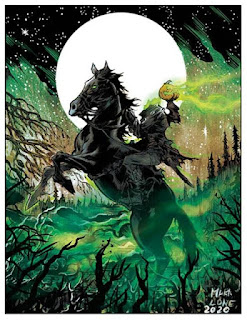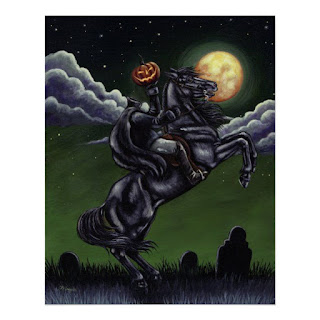The Headless Horseman rides tonight through stark and starless skies, shattering the silence with his otherworldly cries. He races through the darkness on his alabaster steed, the Headless Horseman rides tonight wherever the fates would lead.
With Halloween right around the corner I thought I would try to dig up just exactly where this legend comes from and if I could find any truth behind this hauntingly beloved story.
Let's take a historical in depth look at the Legend of Sleepy Hollow.
The story takes place in the late 1700s in a city called Sleepy Hollow which is near Tarrytown, New York. A school teacher by the name of Ichabod Crane comes to town from Connecticut and finds himself at odds with a local by the name of Abraham “Brom Bones” Van Brunt over a woman named Katrina. Meanwhile, the ghost of a soldier who lost his head to a cannonball during the American Revolution haunts the area every night in search for his missing head.
In American folklore the Headless Horseman was originally known as the "Headless Hessian of the Hollow." His story begins in New York during the Battle of White Plains, just one of the many battles that took place in America's fight for independence from the British. The Horseman was a Hessian trooper who took part in the battle. A Hessian trooper was a German soldier who fought for the British. During the battle, this particular Hessian trooper was unlucky enough to be decapitated by a cannonball. His comrades would carry away his body but they left his head which had been shattered into pieces scattered around the battlefield. They then buried his remains in the old Dutch Church of Sleepy Hollow.
Legend has it he would rise as a vengeful ghost in search of his lost head. The reason they often associated this tale with Halloween and why the Horseman's head is sometimes depicted as a pumpkin is because the battle took place on the 28th of October only a few days before the holiday. Should anyone interrupt the Headless Horseman on his quest to find his head, they are killed.
One night, as he was leaving a party at Katrina’s home, Ichabod found himself face-to-face (so to speak) with the Horseman, never to be heard from again.
The Hudson River Valley, where Tarrytown is located, has a large Dutch population and much of that ‘old country’ folklore finds its way into the stories of Washington Irving. In fact, there is a German legend of the Headless Horseman that has been said to influence the Dutch tales. In one tale, he’s called “The Wild Huntsman” who chases people who have committed terrible crimes through the woods at breakneck speeds, which I'll talk about later.
Irving writes in the story that there is a bridge near an Old Dutch Burying Ground where, legend has it, that if the Horseman attempts to cross it, he will disappear in a great “flash of fire and brimstone.” However, it proves to be not the case as the Horseman races across the bridge and throws his decapitated head at Ichabod. What happens next, is a mystery, but Irving writes that the old Dutch wives will tell the tales and create the legend that Ichabod was “spirited away by supernatural means.”
In reality, the late 1700, near the end of the Revolutionary War, the Hudson River Valley area was equivalent to the wild west – an area of lawbreakers and law-makers, full of rivalries and fighting between British loyalists and American raiders. Also, the area was known for its abundance of Hessian Jagers – German mercenaries who were contracted
by the British Empire to serve during the American Revolutionary War. These Hessians, in addition to being known for their ruthlessness, were also known for their sharpshooting and horsemanship skills.
The area residents, who, as I mentioned, were predominately Dutch settlers, cared little for these German mercenaries and told the tales of the ruthless German horsemen who killed without discretion. At one point, a headless corpse of a Hessian soldier was found in the area and later buried by a local family in an unmarked grave in the Old Dutch Burying Ground.
But what about Ichabod Crane? There was an actual Ichabod Crane who was a military man, a Marine and an Army officer, who served in the War of 1812. Washington Irving met the real Crane at Fort Pike in Sackett’s Harbor, New York in 1814 and was immediately inspired by his name and character. Although, the soldier was nothing like his namesake school teacher.
However, the mannerisms and the behavior of Ichabod Crane are said to be inspired by a friend of Irving’s from Kinderhook, New York. The teacher, Jesse Merwin, was originally from Connecticut and moved to Kinderhook to teach school. Unlike Major Crane, Mr. Merwin was proud of his association with the story.

One of the most interesting things I’ve discovered about the story of Sleepy Hollow is that the town itself wasn’t an actual place until just recently. Well, the location existed, just not in name. In the story, Irving states Sleepy Hollow is “perhaps about three miles” from Tarrytown in “a little valley or rather lap of land among high hills, which is one of the quietest places in the entire world.” The village of North Tarrytown has claimed to be the inspiration for the story for as long as the story has been written, however, many believe that Irving based his story on Kinderhook, where he met his friend Jesse Merwin. It wasn't until 1996 when the North Tarrytown officially adopted the name Sleepy Hollow in honor of the story.
It’s in Sleepy Hollow Cemetery, where Washington Irving is buried along with other famous names like Andrew Carnegie, Walter P. Chrysler, Brooke Astor and Elizabeth Arden.

The idea of the horsemen being decapitated in battle is quite common and it's one we see in Scottish, Welsh and English folklore. In both English and Welsh folklore we have the 14th century or Arthurian poem Sir Gawain and the Green Knight. This story centers on one of the Knights of Arthur's round table who is challenged to a duel by a mysterious Green Knight. However, this isn't really a duel as the Green Knight tells Gawain that he will allow him to strike him once and then he will return the same blow a year and a day later Gawain accepts this challenge and with one swing of the axe he decapitates the Green Knight, but the knight then simply picks up his head, reminds Gawain that he will return in one year's time and then goes on his way. When he eventually finds this mysterious Green Knight, Gawain accepts his fate and in an attempt to keep his honor he leans over expecting the knight to return the blow and strike him down. After, several fake swings of his axe and a brief exchange the Green Knight explains to Gawain that Arthur's sister Morgan La Fey actually transformed him. Theis whole challenge and adventure was merely just a ploy to expose Arthur's knights and to show how chivalrous they really were.
In Scotland the Headless Horseman was said to be a man named Ewan who fought for leadership of his clan. During a battle on the Isle of Mul both Ewan and his horse were decapitated, and this act ended his hopes of ever being the chieftain. But the legend states that both man and horse still haunt the surrounding area even to this day.
This next legend takes us all the way to Northern India and the state of Rajasthan. This variation of the Headless Horseman was seen as a more heroic figure who was said to protect the innocent. These type of stories usually describe the Horseman as being born from a violent death. The most common story is about a prince who was decapitated while defending his village from thieves. Once he was beheaded he continued to defend his people. Although in this version the Horseman was said to fight without a horse so maybe he wasn't truly a Horseman. There is part of the story of a guard about a guard who died defending the Prince in battle. Despite his death the guard continued to defend the Prince, and he enters the battle mounted on a horse without a head.

This next story takes place in Germany where the Brothers Grimm wrote several stories about the Headless Horseman. The first story is set in the town of Dresden and follows a woman who is gathering acorns in a part of the forest named the lost waters. The woman then hears the sound of a hunting horn and when she turns, she sees a man riding a gray horse, which isn't to out of the ordinary so she continues collecting acorns and goes home. She later returns to the forest when she hears a voice from behind her, when she turns around she sees a man dressed in all gray. However, this time he is carrying his head under his arm. He tells the woman that his name is Hans Jagenteufel and during his life he never once listened to the warnings of his father. He told him to be courteous and merciful to all those below him. Yet he did not listen, he often drank to excess and indulged himself far too much without a care for those around him and now in death he was cursed to roam the earth as an evil spirit.
Now remember the story of the wild Huntsman of Brunswick that I told you about earlier? Well the Huntsman went by the name of Hackelberg and on his death bed he begged God to allow him to stay on earth and in exchange he would sacrifice his place in heaven. His request would be granted, but he would remain on earth as a Headless Horseman. Hackelberg was said to blow his horn to warn other hunters that the next day would not be safe for hunting. In some stories he would even seek out and punish those who had wronged others. Accompanied by his pack of black hounds with tongues of fire.
In the end, the headless horseman, as a supernatural entity, represents a past that never dies, but always haunts the living. The headless horseman supposedly seeks revenge and a head which he thinks was unfairly taken from him. This injustice demands that he continually search for a substitute. The horseman, like the past, still seeks answers, still seeks retribution, and can't rest. We are haunted by the past which stalks us so that we never forget it. It also inspires people because it reminds them that there are still some American mysteries, some half-truths that may never be fully known and that's the whole point. The Legend lends itself to any interpretation, and it continues to fascinate and terrify us in the best possible way.























